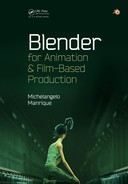Book Description
See Why Blender Is Right for Your Studio’s Pipeline
Blender for Animation and Film-Based Production explores why Blender is ideal for animation films. It demonstrates Blender’s capability to do the job in each production department. Whether you are a beginner or more advanced user, you’ll see why Blender should be taken into consideration in animation and film production.
This Blender reference will help you:
- Manage your projects from start to finish
- Understand the different stages in any animation production
- See how studios work and develop their animation projects
Describing the versatility and power of Blender, the book shows you why studios should incorporate Blender in their pipeline. It avoids tedious tutorials and incomprehensible examples. Instead, the book guides you toward finding efficient solutions for issues with your production files or pipeline. It familiarizes you with the animation industry and explores the risks involved in choosing Blender as a primary tool in animation studios.
Table of Contents
- Preliminaries
- Dedication
- Preface
- Author
- Chapter 1: Why Blender?
- Figure 1.1
- Chapter 2: History of Blender
- Figure 2.1
- Chapter 3: Blender User Interface
- 3.1 Start-Up Blender
- 3.2 Controls and Buttons
- 3.3 Editor System
- 3.4 Editor Types
- 3.4.1 3D View
- 3.4.2 Timeline
- 3.4.3 Graphic Editor
- 3.4.4 DopeSheet
- 3.4.5 NLA Editor
- 3.4.6 UV/Image Editor
- 3.4.7 Video Sequence Editor
- 3.4.8 Text Editor
- 3.4.9 Node Editor
- 3.4.10 Logic Editor
- 3.4.11 Properties Editor
- 3.4.12 Outliner
- 3.4.13 User Preferences
- 3.4.14 Info Window
- 3.4.15 File Browser
- 3.4.16 Console
- 3.5 Modes and Context
- 3.6 Internationalization
- Figure 3.1
- Chapter 4: Blender in a Digital Studio Pipeline
- Figure 4.1
- Chapter 5: Modeling Your Main Character
- Figure 5.1
- Figure 5.1
- Figure 5.2
- Figure 5.3
- Figure 5.4
- Figure 5.5
- Figure 5.6
- Figure 5.7
- Figure 5.8
- Figure 5.9
- Figure 5.10
- Figure 5.11
- Figure 5.12
- Figure 5.13
- Figure 5.14
- Figure 5.15
- Figure 5.16
- Figure 5.17
- Figure 5.18
- Figure 5.19
- Figure 5.20
- Figure 5.21
- Figure 5.22
- Figure 5.23
- Figure 5.24
- Figure 5.25
- Figure 5.26
- Chapter 6: Applying Materials to Our Objects
- Figure 6.1
- Chapter 7: Blender Internal Textures
- Figure 7.1
- Chapter 8: UV Unwrap and External Textures
- Figure 8.1
- Chapter 9: Introduction to Rigging: Armatures and Bones
- Figure 9.1
- Chapter 10: The Animation Process
- Figure 10.1
- Chapter 11: Introduction to Lighting
- Figure 11.1
- Chapter 12: Compositing Nodes
- Figure 12.1
- Chapter 13: Using Particles and Dynamics
- Figure 13.1
- Figure 13.1
- Figure 13.2
- Figure 13.3
- Figure 13.4
- Figure 13.5
- Figure 13.6
- Figure 13.7
- Figure 13.8
- Figure 13.9
- Figure 13.10
- Figure 13.11
- Figure 13.12
- Figure 13.13
- Figure 13.14
- Figure 13.15
- Figure 13.16
- Figure 13.17
- Figure 13.18
- Figure 13.19
- Figure 13.20
- Figure 13.21
- Figure 13.22
- Figure 13.23
- Figure 13.24
- Figure 13.25
- Figure 13.26
- Figure 13.27
- Figure 13.28
- Figure 13.29
- Figure 13.30
- Figure 13.31
- Figure 13.32
- Figure 13.33
- Figure 13.34
- Figure 13.35
- Figure 13.36
- Figure 13.37
- Figure 13.38
- Figure 13.39
- Figure 13.40
- Figure 13.41
- Figure 13.42
- Chapter 14: Render
- Figure 14.1
- Chapter 15: Final Movie Compositing
- Chapter 16: Python
- Figure 16.1
- Chapter 17: Film Promotion and Conclusion
- Appendix
- References
